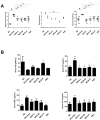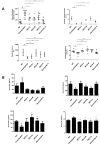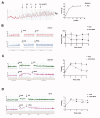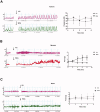Wei Chang An pill regulates gastrointestinal motility in a bidirectional manner
- PMID: 34711130
- PMCID: PMC8555530
- DOI: 10.1080/13880209.2021.1991383
Wei Chang An pill regulates gastrointestinal motility in a bidirectional manner
Abstract
Context: Wei Chang An (WCA) is a commercial prescription developed for the coordination of gastrointestinal movement.
Objective: To investigate the role of WCA in the regulation of diarrhoea and constipation in rats.
Material and methods: The diarrhoea and constipation models were prepared by gavage of Folium senna and diphenoxylate hydrochloride. Rats were randomized equally (n = 6) into the normal group given saline daily, the positive group given Pinaverium Bromide (13.5 mg/kg) or Sennoside A (0.1 mg/kg) and three WCA-treated groups (22, 44, and 88 mg/kg) by gavage daily for 7 consecutive days. The effects of WCA were assessed by a series of faecal symptoms and histopathology. Gastrointestinal parameters were determined by ELISA. The effect of WCA on gastrointestinal tissues was evaluated by strip assay. Expression of ROCK-1 and MLCK was measured by RT-PCR and Western blotting.
Results: Data from Bristol stool form scale, diarrhoea index, visceral sensitivity, defaecation time, and intestinal propulsive rate showed that WCA protected rats against diarrhoea and constipation (p < 0.01). The up-regulation of Substance P and 5-hydroxytryptamine in diarrhoea rats and down-regulation of Substance P and vasoactive intestinal polypeptide in constipation rats were inhibited by WCA (p < 0.05). WCA stimulated the gastrointestinal strip contractions but inhibited ACh-induced contractions (p < 0.01). The decreased ROCK-1 and MLCK expression in diarrhoea rats and increased in constipation rats were suppressed by WCA (p < 0.01).
Conclusions: WCA has both antidiarrhea and anti-constipation effects, suggesting its bidirectional role in gastrointestinal modulation, and providing evidence of WCA for irritable bowel syndrome treatment.
Keywords: Diarrhoea; Rho-associated coiled-coil forming protein kinase-1 (ROCK-1); constipation; irritable bowel syndrome (IBS); myosin light chain kinase (MLCK).
Conflict of interest statement
No potential conflict of interest was reported by the author(s).
Figures








Similar articles
-
Bidirectional effects of methanol extract of Wei-Chang-An pill on gastrointestinal transit and the spasmolytic activity on isolated rat jejunum.J Ethnopharmacol. 2014 Aug 8;155(1):203-12. doi: 10.1016/j.jep.2014.05.017. Epub 2014 Jun 11. J Ethnopharmacol. 2014. PMID: 24928825
-
Protective effect and potential mechanisms of Wei-Chang-An pill on high-dose 5-fluorouracil-induced intestinal mucositis in mice.J Ethnopharmacol. 2016 Aug 22;190:200-11. doi: 10.1016/j.jep.2016.05.057. Epub 2016 May 27. J Ethnopharmacol. 2016. PMID: 27240747
-
[Effect of Fagopyrum cymosum (Trev.) Meisn alcohol extract on defecation and isolated colon of diarrhea-IBS rats and its mechanism].Zhongguo Zhong Xi Yi Jie He Za Zhi. 2014 Dec;34(12):1469-75. Zhongguo Zhong Xi Yi Jie He Za Zhi. 2014. PMID: 25632748 Chinese.
-
Eluxadoline for the treatment of diarrhoea-predominant irritable bowel syndrome.Expert Opin Pharmacother. 2016 Jul;17(10):1395-402. doi: 10.1080/14656566.2016.1182982. Epub 2016 Jun 8. Expert Opin Pharmacother. 2016. PMID: 27267380 Review.
-
Evaluating the functional net value of pharmacologic agents in treating irritable bowel syndrome.Aliment Pharmacol Ther. 2014 May;39(9):973-83. doi: 10.1111/apt.12692. Epub 2014 Mar 11. Aliment Pharmacol Ther. 2014. PMID: 24612075 Review.
Cited by
-
Efficacy and safety of Weichang' an pill combined with Western Medicine on gastrointestinal diseases: a systematic review and Meta-analysis.J Tradit Chin Med. 2023 Oct;43(6):1057-1067. doi: 10.19852/j.cnki.jtcm.20230814.003. J Tradit Chin Med. 2023. PMID: 37946467 Free PMC article.
References
-
- Blennerhassett MG, Lourenssen SR.. 2021. Obligatory activation of SRC and JNK by GDNF for survival and axonal outgrowth of postnatal intestinal neurons. Cell Mol Neurobiol. Online ahead of print. - PubMed
-
- Chen Y, Zheng H, Zhang J, Wang L, Jin Z, Gao W.. 2016. Protective effect and potential mechanisms of Wei-Chang-an pill on high-dose 5-fluorouracil-induced intestinal mucositis in mice. J Ethnopharmacol. 190:200–211. - PubMed
MeSH terms
Substances
Grants and funding
LinkOut - more resources
Full Text Sources
Medical
